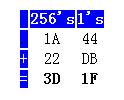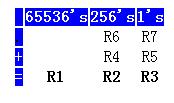


16-Bit Addition
16-bit addition is the addition of two 16-values. First, we must recognize that the addition of two 16-bit values will result in a value that is, at most, 17 bits long. Why is this so? The largest value that can fit in 16-bits is 256 * 256 - 1 = 65,535. If we add 65,535 + 65,535, we get the result of 131,070. This value fits in 17 bits. Thus when adding two 16-bit values, we will get a 17-bit value. Since the 8051 works with 8-bit values, we will use the following statement: "Adding two 16-bit values results in a 24-bit value". Of course, 7 of the highest 8 bits will never be used--but we will have our entire answer in 3 bytes. Also keep in mind that we will be working with unsigned integers.
Let's consider adding the following two decimal values: 6724 + 8923. The answer is, of course, 15647. How do we go about adding these values with the 8051? The first step is to always work with hexadecimal values. Simlply convert the two values you wish to add to hexadecimal. In this case, that is equivalent to the following hexadecimal addition: 1A44 + 22DB.
How do we add thes two numbers? Let's use the exact same method we used in primary school, and in the previous section:

First, notice the difference. We are no longer working with a 1's, 10's, and 100's columns. We are just working with two columns: The 1's column and the 256's column. In familiar computer terms: We're working with the low byte (the 1's column) and the high byte (the 256's column). However, the process is exactly the same.
First we add the values in the 1's column (low byte): 44 + DB = 11F. Only a 2-digit hexadecimal value can fit in a single column, so we leave the 1F in the low-byte column, and carry the 1 to the high-byte column. We now add the high bytes: 1A + 22 = 3C, plus the 1 we carried from the low-byte column. We arrive at the value 3D.
Thus, our completed answer is 3D1F. If we convert 3D1F back to decimal, we arrive at the answer 15647. This matches with the original addition we did in decimal. The process works. Thus the only challenge is to code the above process into 8051 assembly language. As it turns out, this is incredibly easy.
We'll use the following table to explain how we're going to do the addition:

Since we're adding 16-bit values, each value requires two 8-bit registers. Essentially, the first value to add will be held in R6 and R7 (the high byte in R6 and the low byte in R7) while the second value to add will be held in R4 and R5 (the high byte in R4 and the low byte in R5). We will leave our answer in R1, R2, and R3.
Let's review the steps involved in adding the values above:
We'll now convert the above process to assembly language, step by step.
 /5
/5 
文章评论(0条评论)
登录后参与讨论